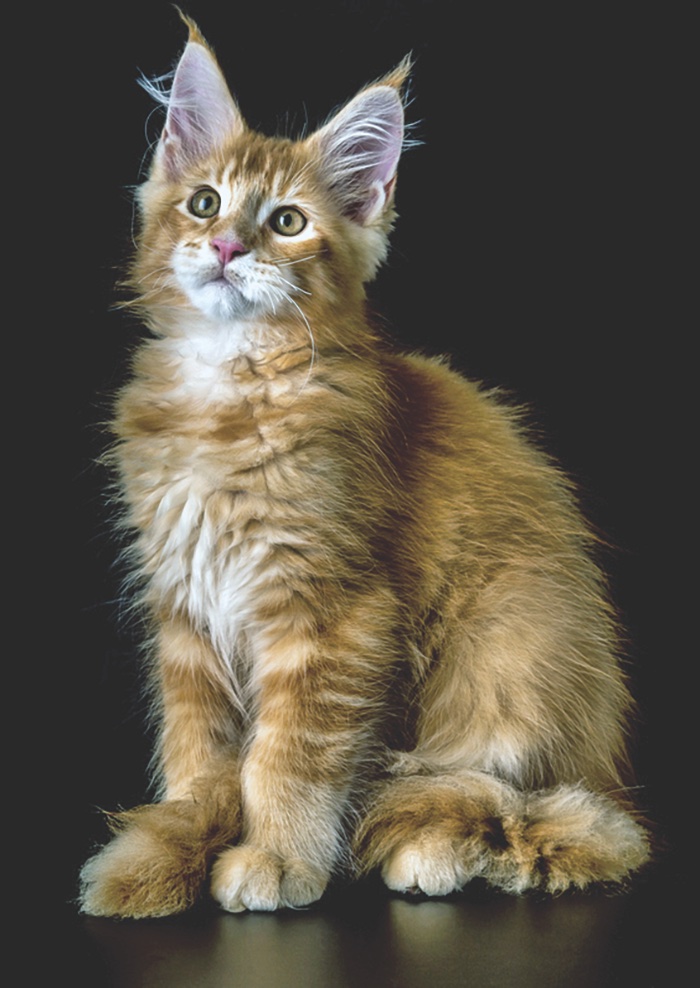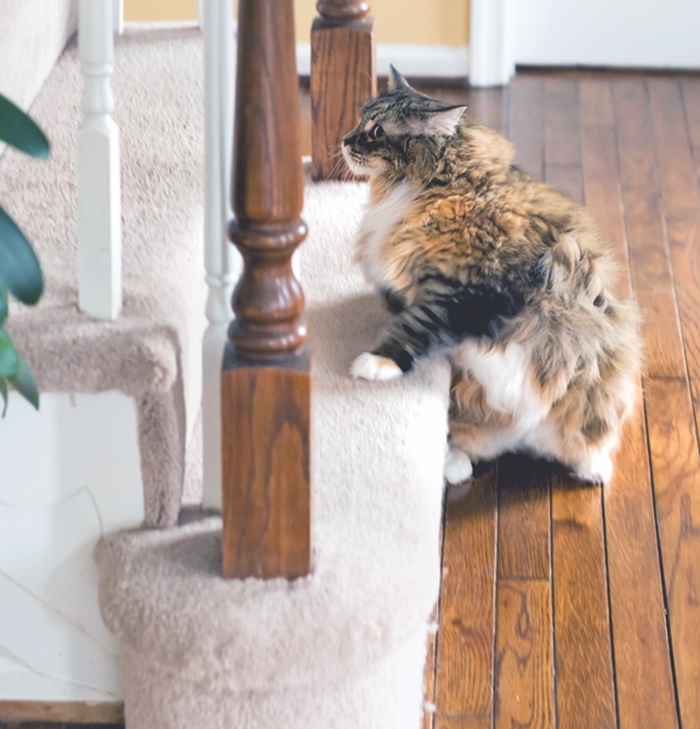Feline hip dysplasia can be a major contributing factor in cats who just seem to “slow down” as they age. While hip arthritis is most commonly due to hip dysplasia, hip arthritis can be secondary to trauma such as being hit by a car.
Signs of hip dysplasia include:
- Limping or other difficulties in walking
- Decreased physical activity, especially jumping and climbing steps
- Pain if the hip is touched
- Persistent licking or chewing at the hip area
- Obesity can significantly worsen arthritis and pain in cats suffering from hip dysplasia.
What Is Hip Dysplasia?
Feline hip dysplasia refers to an abnormal growth/development of the hip joints that results in slippage of the head of the femur (long bone between the knee and the hip) out of the “socket” (acetabulum) of the hip. Considered a genetically-mediated malformation of this ball-and-socket joint, hip dysplasia can cause significant arthritis (joint inflammation), pain, and discomfort in affected hip joints. One or both hip joints can be affected.
A 2018 study* from Cornell University’s College of Veterinary Medicine found that about 25% of the Maine Coon cats evaluated had hip dysplasia, with 56% of these showing evidence of bilateral hip dysplasia (affecting both hips). The bilateral cases in this study tended to be more severe than unilateral ones.
A 2021 study** from the Czech Republic found that the “prevalence of hip joint dysplasia in all pedigree cats was 46.7%, of which 78% of cats had bilateral dysplasia.”
Worsening with Time
Symptoms can vary with the degree of dysplasia, and affected young kittens often run and jump normally. As the kittens age, signs of dysplasia tend to become apparent.
Cats with poor hip conformation tend to avoid jumping and going up and down stairs. You might notice your cat being uncomfortable when she squats to defecate. Some cats hide the problem by being less active, while others may show rear limb lameness. Lameness in cats can be more difficult for the average cat owner to notice than it is for an owner to notice in dogs.
Diagnosis
Hip problems are usually first noticed during physical examination by your veterinarian. Ideally, he/she would like to see your cat move around naturally during this assessment, but cats often hunker down and refuse to move during veterinary visits.
Hip manipulation by your veterinarian may show areas of pain, but some cats are quite stoic, especially in unfamiliar surroundings. Your veterinarian may ask you to video your cat moving at home to evaluate her gait and mobility to address this issue.
Radiographs (X-rays) are essential for a definitive diagnosis, and your cat will usually need to be sedated to position her correctly.
The X-rays can show a shallow acetabulum, a partially or totally dislocated femoral head, and bony changes indicating osteoarthritis if the condition is longstanding.
Both the Orthopedic Foundation for Animals (OFA) and Penn HIP have specific protocols for evaluating hips, and the OFA maintains a database for Maine Coon Cats given their predisposition to hip problems.
Other breeds with a predilection for hip problems include Devon Rex, Abyssinian, Himalayan, and Persian.
Importantly, many senior cats have radiographic changes consistent with hip arthritis even if their hip conformation is good, and their care will be similar to a cat with the abnormal hip conformation seen with dysplasia.
Treatment Is Surgical
There is no cure for a cat with hip dysplasia, but there are two fairly invasive surgical options. The first, called a femoral head ostectomy (FHO), removes the affected femoral head.
Once the femoral head is removed, the muscles of the hip preserve the hip function and the joint friction that caused the pain is removed.
This surgery is often recommended for cats with severely fractured femoral heads due to trauma, but it can also provide relief for cats with hip dysplasia. The younger a cat is, the faster he will heal, and weeks of restricted activity are required during recovery.
Cats who have FHO may retain a slight limp, but they are usually relatively pain-free upon full recovery. The leg that has been operated on may end up slightly shorter than the other, but most cats that undergo this procedure end up with a normal or near-normal range of motion and good function.
The second surgical option is a hip replacement, a procedure that is rarely performed in cats. Since their bones are so small and fragile compared to those of a large dog or a person, complications are common in cats that undergo this delicate surgery.
“Much information in human medicine points to targeting strength training of the hip stabilizing muscles. Such muscles cross the joint and are responsible for active stabilization, which is particularly important in patients experiencing hip laxity (looseness) associated with dysplasia,” says Dr. Chris Frye, associate professor in the section of sports medicine and rehabilitation at Cornell University’s College of Veterinary Medicine.
“Daily low-impact exercise and even aquatic exercise has been shown to reduce pain, increase mobility, improve endurance, and strengthen the hip muscles,” says Dr. Frye.
“We have cats participate in water treadmill, but some cats will also willingly swim in bathtubs or pools at home under appropriate supervision/assistance,” he says.
“Other therapeutic exercises one can try are training a cat to sit to stand for treats or having them place their paws up on a step for treats. These exercises strengthen the gluteals, a major hip stabilizer. Other exercises can include stepping sideways in both directions to target the inner and outer thigh muscles,” says Dr. Frye.
Rehab Program

Maine Coon Cat breeders are making a conscious effort to reduce hip problems in their breed. With 1,568 Maine Coon cats screened through the OFA, 25.8% percent showed radiographic evidence of hip dysplasia.
“When discussing rehabilitation for cats with hip dysplasia, we try to set up a well-rounded rehabilitation program. This includes weight management, environmental modifications, proper exercise, joint supplementation, and if necessary, pain medication,” says Jennifer Cromp, LVT, CCRP at Village Veterinary Hospital in Canastota, N.Y.
Maintaining or achieving a lean body mass will help with comfort and mobility. A 2023 study*** from the United Kingdom showed that even cats who had significant weight loss despite not reaching their target weight had dramatically improved mobility/quality of life.
Note: Care must be taken when devising a weight-loss program for cats, because too drastic a reduction in caloric intake/drop in weight can cause fatty liver disease, which can be fatal. It is important to work closely with your veterinarian when devising a weight loss plan for your cat.
You can also manage your cat’s environment to minimize discomfort if he is suffering from hip dysplasia (or any arthritis).
Cromp suggests placing food and water bowls and litter trays in places that don’t force the cat to have to climb stairs or jump up on an elevated surface. Short sides on the litterbox make it easier for your cat to get in and out, and ramps can help cats get up to favorite windowsills or perching spots.
Encouraging activity and movement also helps to maintain the cat’s muscle tone and fitness.
“This can be achieved by separating meals into smaller bowls and placing them around the house, so the cat must walk from one dish to the other, thereby increasing daily walking. Performing range of motion exercises can be helpful if the cat will allow it. Playing with a laser pointer can also encourage movement, but should be done in a controlled fashion,” says Cromp.
Encourage your cat to exercise through play and environmental management to stimulate activity. Feed meals at specific times instead of free feeding so you can control caloric intake, and limit treats.
Cromp says she thinks that the most useful tool for hip dysplasia in cats is therapeutic laser therapy, although this is controversial.
In theory, the laser may help reduce inflammation and improve blood flow, which can help control pain. While anecdotal reports of improvement using laser therapy exist, scientific validation of the effectiveness is lacking.
While the use of pulsed electromagnetic field therapy may, in theory, reduce inflammation and improve blood flow to the hip joint and muscles in affected cats, scientific validation of the usefulness of this therapy in cats with hip dysplasia is also lacking at this time.
Owners can learn to do at-home range-of-motion exercises and massage techniques that may help to keep their cats comfortable.
Joint supplements may help ease some discomfort within the joints of cats with hip dysplasia, but “there are only a few studies of the usefulness of supplements for feline osteoarthritis,” says Dr. Frye.
“Fish oil with or without glucosamine chondroitin is the only clinically researched supplement in feline medicine, with three studies highlighted in a 2022 systematic review by Barbeau-Gregoire and colleagues.
“Prescription feline therapeutic joint diets are based upon available supplement principles and research. A newer supplement on the market that shows some promise is CBD (cannabadiol) nutraceuticals. While CBD has been shown to improve mobility and well-being in dogs with arthritis, data regarding its efficacy, safety, and dosing in cats are currently lacking. Regardless of which supplement or diet is used, it must, of course, be healthy and palatable for our feline friends,” says Dr. Frye.
Your veterinarian can also prescribe pain medications for cats who are in discomfort. Solensia (frunevetmab) is an FDA-approved monthly injection designed to help cats with osteoarthritic pain. This does require monthly trips to the vet clinic, but it also saves the hassle of daily pilling.
If you are considering obtaining a cat of a breed that is predisposed to hip dysplasia, ask the breeder whether screening for this disease was performed. Such screening is not a guarantee that hip problems will not ultimately occur, but it does minimize the risks.ν
*Loder, RT, Todhunter RJ. Demographics of hip dysplasia in the Maine Coon cat. Journal of Feline Medicine and Surgery. 2017;20(4):302-307. doi:10.1177/1098612X17705554
** Černá P, et al. The Prevalence of Feline Hip Dysplasia, Patellar Luxation and Lumbosacral Transitional Vertebrae in Pedigree Cats in The Czech Republic. Animals (Basel). 2021 Aug 24;11(9):2482. doi: 10.3390/ani11092482. PMID: 34573448; PMCID: PMC8465978.
*** German AJ, et al. Partial weight reduction protocols in cats lead to better weight outcomes, compared with complete protocols, in cats with obesity. Front Vet Sci. 2023 Jun 20;10:1211543. doi: 10.3389/fvets.2023.1211543. PMID: 37408831; PMCID: PMC10318927.
Christopher Frye, DVM, is a veterinary sports medicine and rehabilitation specialist at Cornell University’s College of Veterinary Medicine.



